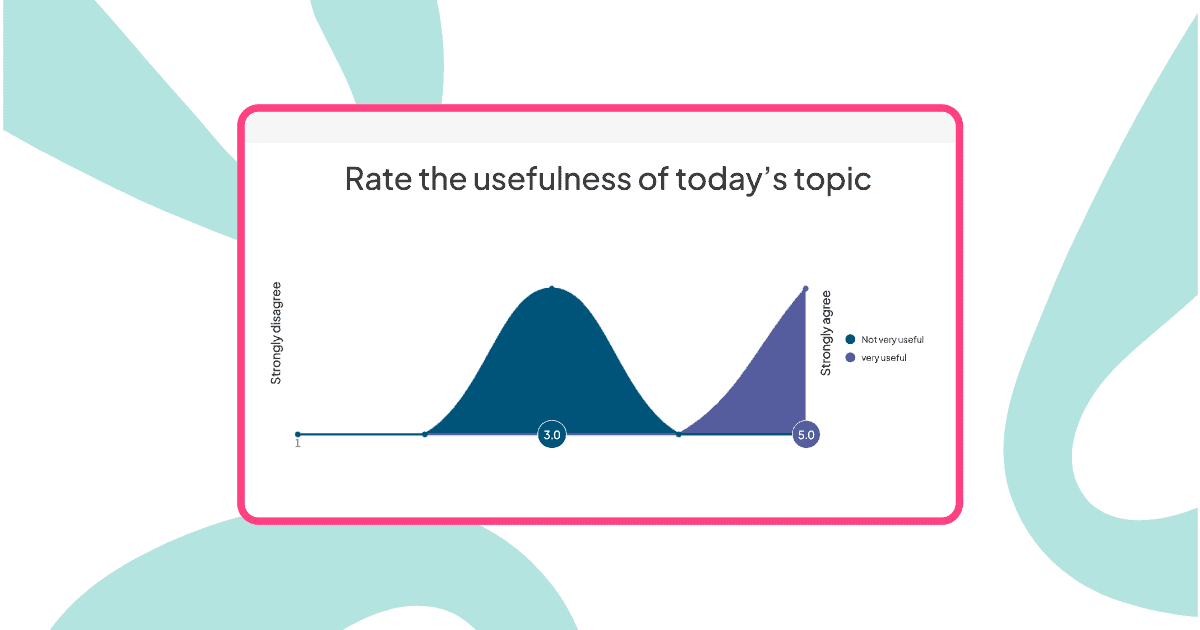Har du någonsin undrat hur dina anställda verkligen känner inför sina roller, bidrag och övergripande arbetstillfredsställelse?
En givande karriär är inte längre begränsad till en löneutbetalning i slutet av månaden. I en tid av distansarbete, flexibla arbetstider och föränderliga arbetsroller har definitionen av arbetstillfredsställelse förändrats dramatiskt.
Problemet är: traditionella årliga undersökningar ger ofta låga svarsfrekvenser, fördröjda insikter och rengjorda svar. Anställda fyller i dem ensamma vid sina skrivbord, avskilda från nuet och rädda för att bli identifierade. När du väl analyserar resultaten har problemen antingen eskalerat eller glömts bort.
Det finns ett bättre sätt. Interaktiva arbetstillfredsställelsesundersökningar som genomförs under teammöten, möten eller utbildningar fångar upp autentisk feedback i stunden – när engagemanget är som högst och du kan ta itu med dina problem i realtid.
I den här guiden kommer vi att ge 46 exempelfrågor till din arbetstillfredsställelseenkät, visar dig hur du omvandlar statiska undersökningar till engagerande samtal och hjälper dig att främja en arbetsplatskultur som främjar medarbetarengagemang, stimulerar innovation och banar väg för varaktig framgång.
Innehållsförteckning
- Vad är ett arbetstillfredsställelseformulär?
- Varför genomföra en arbetstillfredsställelseenkät?
- Skillnaden mellan traditionella och interaktiva undersökningar
- 46 exempelfrågor för ett arbetstillfredsställelseformulär
- Hur man genomför en effektiv arbetstillfredsställelsesundersökning med AhaSlides
- Varför interaktiva undersökningar fungerar bättre än traditionella formulär
- Key Takeaways
Vad är ett arbetstillfredsställelseformulär?
En arbetstillfredsställelsesenkät, även känd som en medarbetarundersökning, är ett strategiskt verktyg som används av HR-experter och organisationsledare för att förstå hur tillfredsställda deras anställda är i sina roller.
Den består av noggrant utformade frågor som är utformade för att täcka kritiska områden inklusive arbetsmiljö, arbetsuppgifter, relationer med kollegor och handledare, ersättning, utvecklingsmöjligheter, välbefinnande och mer.
Det traditionella tillvägagångssättet: Skicka ut en länk till enkäten, vänta på att svaren ska komma in, analysera data veckor senare och implementera sedan förändringar som känns osammanhängande med de ursprungliga tankarna.
Det interaktiva tillvägagångssättet: Presentera frågor live under möten, samla omedelbar feedback genom anonyma omröstningar och ordmoln, diskutera resultat i realtid och utveckla tillsammans lösningar medan samtalet är färskt.
Varför genomföra en arbetstillfredsställelseenkät?
Pews forskning framhäver att nästan 39 % av icke-egenföretagare anser att deras jobb är avgörande för deras övergripande identitet. Denna uppfattning formas av faktorer som familjeinkomst och utbildning, där 47 % av höginkomsttagarna och 53 % av doktoranderna tillskriver sin arbetsidentitet betydelse. Detta samspel är avgörande för medarbetarnöjdhet, vilket gör ett välstrukturerat enkätundersökningsformulär avgörande för att främja meningsfullhet och välbefinnande.
Att genomföra en enkät om arbetstillfredsställelse erbjuder betydande fördelar för både anställda och organisationen:
Insiktsfull förståelse
Specifika frågor avslöjar medarbetarnas verkliga känslor, åsikter, oro och områden där de är nöjda. När de genomförs interaktivt med anonyma svarsalternativ undviker man rädslan för identifiering som ofta leder till oärlig feedback i traditionella undersökningar.
Identifiering av problem
Riktade frågor identifierar smärtpunkter som påverkar moral och engagemang – oavsett om det gäller kommunikation, arbetsbelastning eller utvecklingsmöjligheter. Ordmoln i realtid kan omedelbart visualisera var de flesta anställda kämpar.
Skräddarsydda lösningar
Insamlade insikter möjliggör skräddarsydda lösningar, vilket visar ert engagemang för att förbättra arbetsförhållandena. När medarbetare ser sin feedback visas omedelbart och diskuteras öppet, känner de sig genuint hörda snarare än bara tillfrågade.
Ökat engagemang och kundlojalitet
Att ta itu med frågor baserat på enkätresultat ökar engagemanget, vilket bidrar till lägre personalomsättning och ökad lojalitet. Interaktiva undersökningar förvandlar feedbackinsamling från en byråkratisk övning till en meningsfull konversation.
Skillnaden mellan traditionella och interaktiva undersökningar
| Aspect | Traditionell undersökning | Interaktiv undersökning (AhaSlides) |
|---|---|---|
| Tidpunkten | Skickas via e-post, slutförs ensam | Livesänds under möten |
| Svar åt | 30–40 % i genomsnitt | 85–95 % vid livepresentation |
| anonymitet | Tveksamt – anställda oroar sig för spårning | Sann anonymitet utan inloggning |
| Engagemang | Känns som läxor | Känns som ett samtal |
| Resultat | Dagar eller veckor senare | Omedelbar visualisering i realtid |
| Handling | Försenad, frånkopplad | Omedelbara diskussioner och lösningar |
| Format | Statiska former | Dynamiska omröstningar, ordmoln, frågor och svar, betyg |
Nyckelinsikten: Människor engagerar sig mer när feedback känns som dialog snarare än dokumentation.
46 exempelfrågor för ett arbetstillfredsställelseformulär
Här är exempelfrågor ordnade efter kategori. Varje avsnitt innehåller vägledning om hur man presenterar dem interaktivt för maximal ärlighet och engagemang.
Arbetsmiljö
frågor:
- Hur skulle du bedöma den fysiska komforten och säkerheten på din arbetsplats?
- Är du nöjd med renligheten och organisationen på arbetsplatsen?
- Upplever du att kontorsatmosfären främjar en positiv arbetskultur?
- Får du de nödvändiga verktygen och resurserna för att utföra ditt jobb effektivt?
Interaktiv metod med AhaSlides:
- Använd betygsskalor (1–5 stjärnor) som visas live
- Följ upp med ett öppet ordmoln: "Beskriv vår arbetsplatsatmosfär med ett ord"
- Aktivera anonymt läge så att anställda ärligt bedömer fysiska förhållanden utan rädsla
- Visa aggregerade resultat omedelbart för att starta diskussionen
Varför detta fungerar: När anställda ser att andra delar liknande problem (t.ex. flera personer betygsätter "verktyg och resurser" som 2/5), känner de sig bekräftade och mer villiga att utveckla frågorna i uppföljande frågestunder.
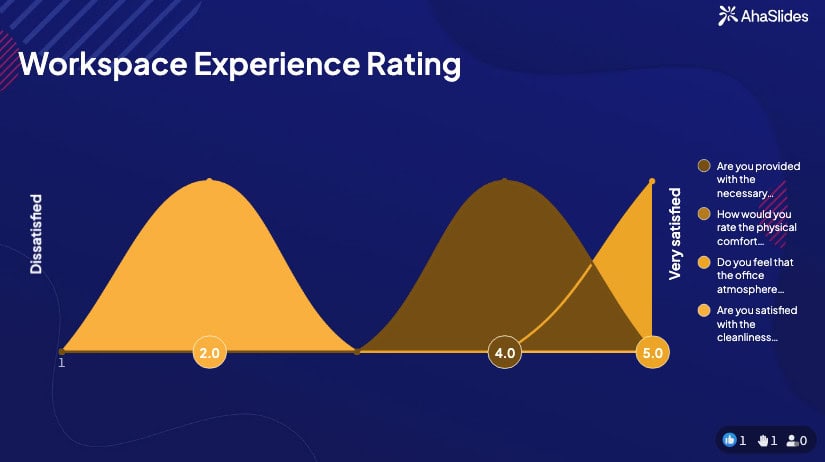
Testa en mall för enkät om arbetsmiljö →
Jobbansvar
frågor:
- Stämmer dina nuvarande arbetsuppgifter med dina kunskaper och kvalifikationer?
- Är dina uppgifter tydligt definierade och kommunicerade till dig?
- Har du möjligheter att anta nya utmaningar och utöka din kompetens?
- Är du nöjd med variationen och komplexiteten i dina dagliga uppgifter?
- Känner du att ditt jobb ger dig en känsla av mening och uppfyllelse?
- Är du nöjd med nivån på beslutsbefogenheter du har i din roll?
- Anser du att dina arbetsuppgifter överensstämmer med organisationens övergripande mål och uppdrag?
- Får du tydliga riktlinjer och förväntningar på dina arbetsuppgifter och projekt?
- Hur väl känner du att dina arbetsuppgifter bidrar till företagets framgång och tillväxt?
Interaktiv metod med AhaSlides:
- Presentera ja/nej-omröstningar för att få klarhetsfrågor (t.ex. "Är dina uppgifter tydligt definierade?")
- Använd betygsskalor för nöjdhetsnivåer
- Följ upp med öppen frågestund: "Vilka ansvarsområden skulle du vilja lägga till eller ta bort?"
- Skapa ett ordmoln: "Beskriv din roll med tre ord"
Pro tips: Den anonyma fråge- och svarsfunktionen är särskilt kraftfull här. Anställda kan skicka in frågor som "Varför har vi inte mer självständighet i beslutsfattandet?" utan rädsla för att bli identifierade, vilket gör det möjligt för chefer att ta itu med systemiska problem öppet.
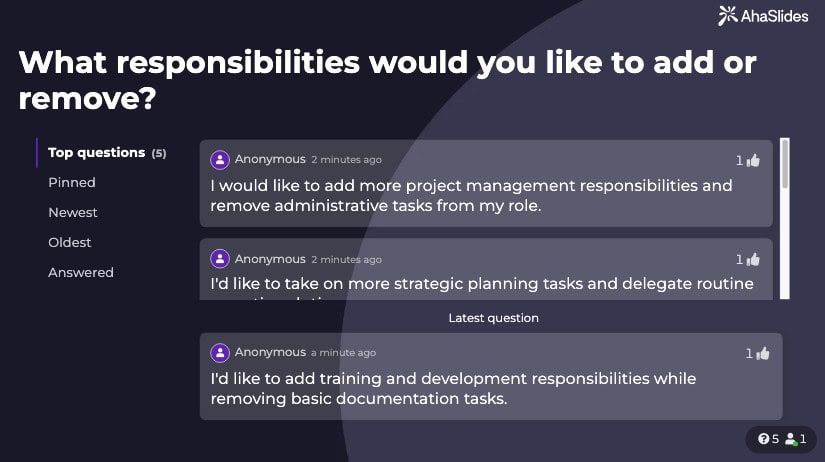
Handledning och ledarskap
frågor:
- Hur skulle du bedöma kvaliteten på kommunikationen mellan dig och din handledare?
- Får du konstruktiv feedback och vägledning om din prestation?
- Uppmuntras du att framföra dina åsikter och förslag till din handledare?
- Känner du att din chef värdesätter dina bidrag och erkänner dina ansträngningar?
- Är du nöjd med ledarstilen och ledarsättet inom din avdelning?
- Vilka typer av ledarskapsförmågor tror du skulle vara mest effektiva i ditt team?
Interaktiv metod med AhaSlides:
- Använd anonyma bedömningsskalor för känslig feedback från handledare
- Presentera alternativa ledarstilar (demokratisk, coachande, transformerande, etc.) och fråga vilka medarbetare föredrar
- Möjliggör live frågestund där anställda kan ställa frågor om ledningens tillvägagångssätt
- Skapa rankningar: "Vad är viktigast för dig hos en handledare?" (Kommunikation, Erkännande, Feedback, Autonomi, Stöd)
Varför anonymitet är viktigt: Enligt ert positioneringsarbetsblad behöver HR-experter "skapa trygga utrymmen för ärliga diskussioner". Interaktiva anonyma omröstningar under möten gör det möjligt för anställda att betygsätta ledarskapet ärligt utan karriärbekymmer – något som traditionella undersökningar har svårt att uppnå på ett övertygande sätt.
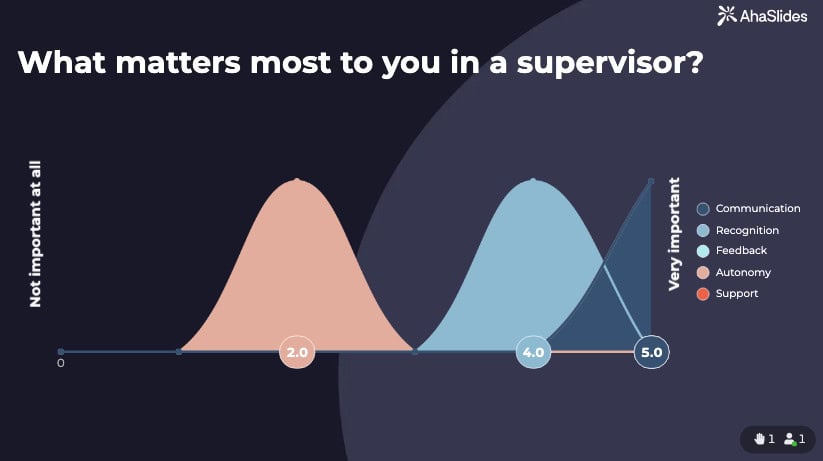
Karriärtillväxt och utveckling
frågor:
- Får du möjligheter till professionell utveckling och avancemang?
- Hur nöjd är du med de utbildnings- och utvecklingsprogram som organisationen erbjuder?
- Tror du att din nuvarande roll överensstämmer med dina långsiktiga karriärmål?
- Får du chansen att ta på dig ledarroller eller speciella projekt?
- Får du stöd för att fortsätta utbildning eller kompetenshöjning?
Interaktiv metod med AhaSlides:
- Undersökning: "Vilken typ av professionell utveckling skulle gynna dig mest?" (Ledarskapsutbildning, Tekniska färdigheter, Certifieringar, Mentorskap, Sidoförflyttningar)
- Ordmoln: "Var ser du dig själv om 3 år?"
- Skattskala: "Hur mycket känner du dig stöttad i din karriärutveckling?" (1-10)
- Öppna frågor och svar för anställda att fråga om specifika utvecklingsmöjligheter
Strategisk fördel: Till skillnad från traditionella undersökningar där dessa data finns i ett kalkylblad, gör presentationen av karriärutvecklingsfrågor live under kvartalsvisa uppföljningar det möjligt för HR att omedelbart diskutera utbildningsbudgetar, mentorskapsprogram och interna mobilitetsmöjligheter medan samtalet pågår.
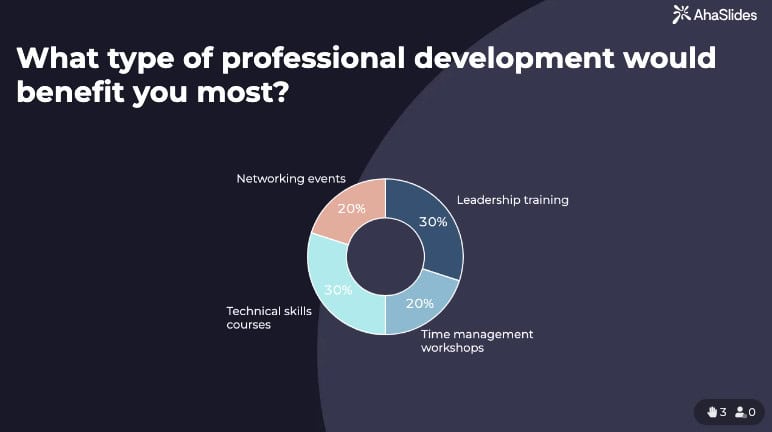
Ersättning och förmåner
frågor:
- Är du nöjd med din nuvarande lön och kompensationspaket, inklusive förmåner?
- Känner du att dina bidrag och prestationer belönas på lämpligt sätt?
- Är de förmåner som organisationen erbjuder heltäckande och lämpliga för era behov?
- Hur skulle du bedöma transparensen och rättvisan i prestationsutvärderingen och kompensationsprocessen?
- Är du nöjd med möjligheterna till bonusar, incitament eller belöningar?
- Är du nöjd med semesterpolicyn?
Interaktiv metod med AhaSlides:
- Anonyma ja/nej-omröstningar för känsliga lönefrågor
- Flervalsfrågor: "Vilka förmåner är viktigast för dig?" (Hälsovård, Flexibilitet, Utbildningsbudget, Friskvårdsprogram, Pension)
- Betygsskala: "Hur rättvis är vår ersättning i förhållande till ditt bidrag?"
- Ordmoln: "Vilken fördel skulle förbättra din tillfredsställelse mest?"
Kritisk anmärkning: Det är här anonyma interaktiva undersökningar verkligen lyser. Anställda ger sällan ärlig feedback på lön i traditionella undersökningar som kräver inloggningsuppgifter. Anonyma liveundersökningar under möten, där svaren visas utan namn, skapar psykologisk trygghet för genuin feedback.
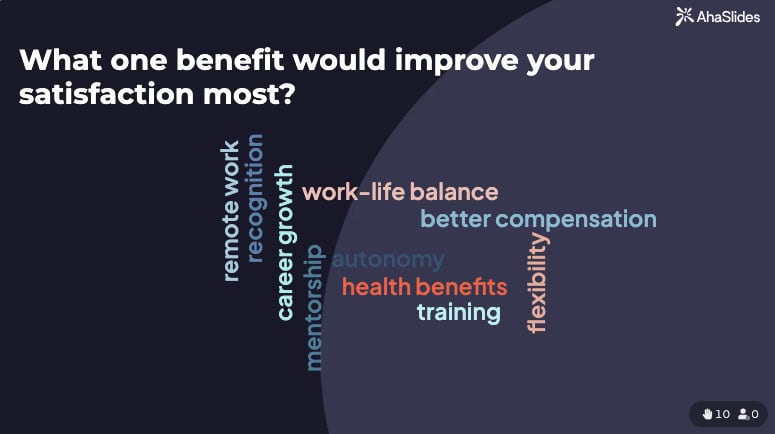
Skapa din feedbacksession för ersättning →
Relationer och samarbete
frågor:
- Hur bra samarbetar och kommunicerar du med dina kollegor?
- Känner du en känsla av kamratskap och lagarbete inom din avdelning?
- Är du nöjd med respekten och samarbetet mellan dina kollegor?
- Har du möjligheter att interagera med kollegor från olika avdelningar eller team?
- Är du bekväm med att söka hjälp eller råd från dina kollegor när det behövs?
Interaktiv metod med AhaSlides:
- Betygsskalor för samarbetets kvalitet
- Ordmoln: "Beskriv vår teamkultur med ett ord"
- Flervalsfråga: "Hur ofta samarbetar du mellan avdelningar?" (Dagligen, Veckovis, Månadsvis, Sällan, Aldrig)
- Anonyma frågor och svar för att belysa interpersonella problem
Välbefinnande och balans mellan arbete och privatliv
frågor:
- Hur nöjd är du med den balans mellan arbete och privatliv som organisationen erbjuder?
- Känner du dig tillräckligt stödd av företaget för att hantera stress och upprätthålla ditt psykiska välbefinnande?
- Är du bekväm med att söka hjälp eller resurser för att hantera personliga eller arbetsrelaterade utmaningar?
- Hur ofta deltar du i hälsoprogram eller aktiviteter som organisationen tillhandahåller?
- Tror du att företaget värdesätter och prioriterar sina anställdas välbefinnande?
- Är du nöjd med den fysiska arbetsmiljön vad gäller komfort, belysning och ergonomi?
- Hur väl tillgodoser organisationen dina behov gällande hälsa och välbefinnande (t.ex. flexibla arbetstider, alternativ för distansarbete)?
- Känner du dig uppmuntrad att ta pauser och koppla av från jobbet när det behövs för att ladda?
- Hur ofta känner du dig överväldigad eller stressad på grund av jobbrelaterade faktorer?
- Är du nöjd med de hälso- och välbefinnandeförmåner som organisationen erbjuder?
Interaktiv metod med AhaSlides:
- Frekvensskalor: "Hur ofta känner du dig stressad?" (Aldrig, Sällan, Ibland, Ofta, Alltid)
- Ja/nej-omröstningar om välbefinnandestöd
- Anonym slider: "Betygsätt din nuvarande utbrändhetsnivå" (1-10)
- Ordmoln: "Vad skulle förbättra ditt välbefinnande mest?"
- Öppna frågestunder för anställda att anonymt dela välbefinnandefrågor
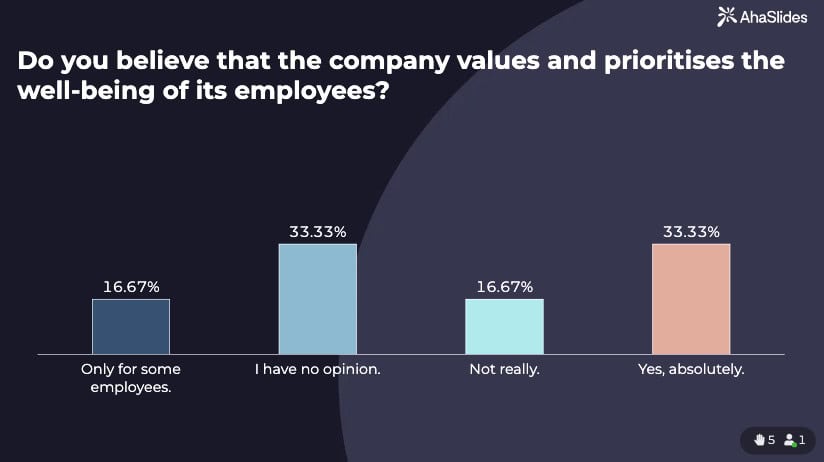
Varför det här är viktigt: Ert positioneringsarbetsblad identifierar att HR-personal kämpar med "medarbetarengagemang och feedback" och "att skapa trygga utrymmen för ärliga diskussioner". Välbefinnandefrågor är i sig känsliga – anställda är rädda för att verka svaga eller oengagerade om de erkänner utbrändhet. Interaktiva anonyma undersökningar tar bort detta hinder.
Övergripande tillfredsställelse
Slutfråga: 46. På en skala från 1–10, hur sannolikt är det att du skulle rekommendera det här företaget som en bra arbetsplats? (Employee Net Promoter Score)
Interaktivt tillvägagångssätt:
- Uppföljning baserat på resultat: Om poängen är låga, fråga omedelbart "Vad är det enda vi skulle kunna ändra för att förbättra ditt resultat?"
- Visa eNPS i realtid så att ledningen omedelbart ser sentimentet
- Använd resultaten för att driva transparenta samtal om organisatoriska förbättringar
Hur man genomför en effektiv arbetstillfredsställelsesundersökning med AhaSlides
Steg 1: Välj ditt format
Alternativ A: Live under möten med alla personer
- Presentera 8–12 viktiga frågor under kvartalsvisa möten
- Använd anonymt läge för känsliga ämnen
- Diskutera resultaten omedelbart med gruppen
- Bäst för: Bygga förtroende, omedelbara åtgärder, gemensam problemlösning
Alternativ B: Självstudier men interaktiva
- Dela en presentationslänk som anställda kan komma åt när som helst
- Inkludera alla 46 frågor sorterade efter kategori
- Sätt en deadline för slutförande
- Bäst för: Omfattande datainsamling, flexibel tidsplanering
Alternativ C: Hybridmetod (rekommenderad)
- Skicka 5–7 kritiska frågor som omröstningar i självstudier
- Presentera resultat och de 3 viktigaste problemen live på nästa teammöte
- Använd live-frågestunder för att fördjupa dig i frågor
- Bäst för: Maximalt deltagande med meningsfull diskussion
Steg 2: Konfigurera din undersökning i AhaSlides
Funktioner att använda:
- Betygsskalor för nöjdhetsnivåer
- Flervalsundersökningar för preferensfrågor
- Ordmoln att visualisera gemensamma teman
- Öppna Q&A för anställda att ställa anonyma frågor
- Anonymt läge för att garantera psykologisk trygghet
- Visa resultat i realtid att visa transparens
Tidsbesparande tips: Använd AhaSlides AI-generator för att snabbt skapa din undersökning från den här frågelistan och anpassa den sedan efter din organisations specifika behov.
Steg 3: Kommunicera syftet
Innan du startar din undersökning, förklara:
- Varför ni genomför det (inte bara "för att det är dags för årliga undersökningar")
- Hur svaren kommer att användas
- Att anonyma svar verkligen är anonyma
- När och hur du kommer att dela resultat och vidta åtgärder
Manus för att bygga förtroende: "Vi vill förstå hur du verkligen känner inför att arbeta här. Vi använder anonyma interaktiva omröstningar eftersom vi vet att traditionella undersökningar inte fångar upp din ärliga feedback. Dina svar visas utan namn, och vi kommer att diskutera resultaten tillsammans för att tillsammans utveckla lösningar."
Steg 4: Presentera live (om tillämpligt)
Mötesstruktur:
- Introduktion (2 min): Förklara syftet och anonymiteten
- Enkätfrågor (15–20 min): Presentera omröstningar en efter en, visar liveresultat
- Diskussion (15–20 min): Ta itu med de största problemen omedelbart
- Handlingsplanering (10 min): Åtgärda specifika nästa steg
- Uppföljande frågor och svar (10 min): Öppet golv för anonyma frågor
Pro tips: När känsliga resultat uppstår (t.ex. 70 % bedömer ledarskapets kommunikation som dålig), bekräfta dem omedelbart: "Detta är viktig feedback. Låt oss diskutera vad 'dålig kommunikation' betyder för dig. Använd frågestunden för att dela specifika exempel anonymt."
Steg 5: Agera utifrån resultaten
Det är här interaktiva undersökningar skapar konkurrensfördelar. Eftersom du har samlat in feedback under livekonversationer:
- Anställda har redan sett resultat
- Du har åtagit dig handlingar offentligt
- Uppföljning förväntas och syns
- Förtroende byggs upp när löften hålls
Mall för handlingsplan:
- Dela detaljerade resultat inom 48 timmar
- Identifiera de 3 främsta områdena för förbättring
- Bilda arbetsgrupper för att utveckla lösningar
- Kommunicera framsteg varje månad
- Återuppnå enkäten om 6 månader för att mäta förbättringen
Varför interaktiva undersökningar fungerar bättre än traditionella formulär
Enligt era organisationsbehov behöver ni:
- "Mät medarbetarengagemang under HR-initiativ"
- "Underlätta anonyma frågestunder i kommunhusen"
- "Samla in medarbetarnas åsikter med hjälp av ordmoln och liveundersökningar"
- "Skapa trygga utrymmen för ärliga diskussioner"
Traditionella enkätverktyg som Google Forms eller SurveyMonkey kan inte leverera den här upplevelsen. De samlar in data, men de skapar inte dialog. De samlar in svar, men de bygger inte förtroende.
Interaktiva plattformar som AhaSlides förvandlar feedbackinsamling från en byråkratisk övning till en meningsfull konversation. där:
- Anställda ser att deras röster spelar roll i realtid
- Ledare visar omedelbart engagemang för att lyssna
- Anonymitet tar bort rädsla medan transparens bygger förtroende
- Diskussion leder till gemensamma lösningar
- Data blir en konversationsstartare, inte en rapport som ligger i en låda
Key Takeaways
✅ Arbetsnöjdhetsundersökningar är strategiska verktyg, inte administrativa kryssrutor. De avslöjar vad som driver engagemang, kundlojalitet och prestanda.
✅ Interaktiva undersökningar ger bättre resultat än traditionella former – högre svarsfrekvens, mer ärlig feedback och omedelbara diskussionsmöjligheter.
✅ Anonymitet plus transparens skapar den psykologiska trygghet som behövs för genuin feedback. Anställda svarar ärligt när de vet att svaren är anonyma men ser att ledarna agerar.
✅ De 46 frågorna i den här guiden täcker kritiska dimensioner av arbetstillfredsställelse: miljö, ansvar, ledarskap, utveckling, ersättning, relationer och välbefinnande.
✅ Resultat i realtid möjliggör omedelbara åtgärder. När medarbetare ser sin feedback visualiserad direkt och diskuterad öppet, känner de sig hörda snarare än bara tillfrågade.
✅ Verktyg spelar roll. Plattformar som AhaSlides med liveomröstningar, ordmoln, anonyma frågor och svar och resultat i realtid förvandlar statiska frågeformulär till dynamiska samtal som driver organisatorisk förändring.
Referenser:




